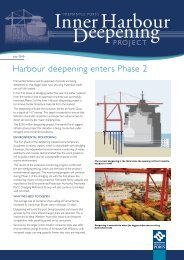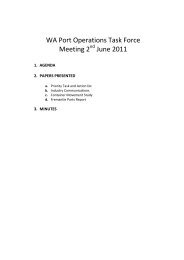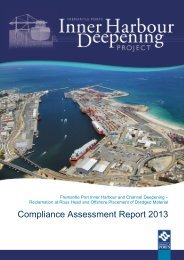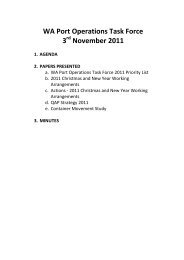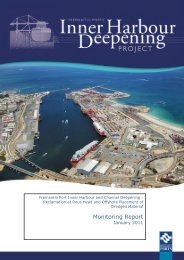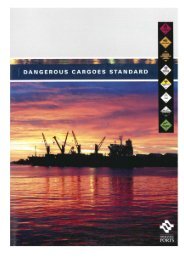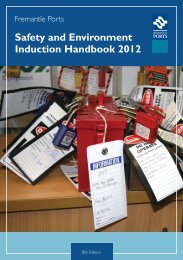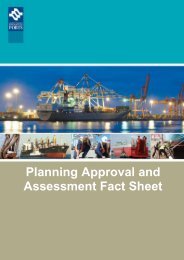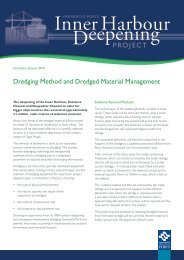Fremantle Port Inner Harbour and Channel ... - Fremantle Ports
Fremantle Port Inner Harbour and Channel ... - Fremantle Ports
Fremantle Port Inner Harbour and Channel ... - Fremantle Ports
- No tags were found...
Create successful ePaper yourself
Turn your PDF publications into a flip-book with our unique Google optimized e-Paper software.
Conclusions <strong>and</strong> RecommendationsThe substrates were classified into two tiers of information across the study area based on integratinginformation from both GE-1 <strong>and</strong> WV-2 imagery, GEOBIA analysis <strong>and</strong> field data integration. Waterconditions at the time of image acquisition impacted the overall classification in combination with thewater depth associated with the site. Derived classifications from optical sensors perform best whenanalysing substrates in shallow water environments where water depths do not exceed 15m. Siteswhere median depths are considered beyond the shallow water environment are more susceptible tosignificant impacts from imagery artefacts <strong>and</strong> there is an increased risk of not detecting true sea floorconditions. Turbidity, water quality, wave <strong>and</strong> current conditions, sun angle at the time of imagecapture <strong>and</strong> capture angle of the sensor all contribute to providing suitable conditions for opticalimagery analysis in marine environments.Uncertainty in the results increased with depth, particularly beyond the 20m depth contour <strong>and</strong> wherecompounding artefacts were present in the imagery. The GE-1 data in combination with the WV-2data was able to provide information on which to base the indicative extent of substrates.The Tier 1 substrate classification discriminated between light <strong>and</strong> dark substrates <strong>and</strong> the Tier 2classification was able to attribute the dark substrate into substrates either dominated by rock orseagrass communities. There may be other less dominant substrates present on the site such aspresence of algae on rock or finer pebble substrates, however, these were deemed beyond theclassification scale for this project given the overall limitations as discussed above.The integration of the field data with the satellite imagery enabled the derivation of the Tier 2classification from the Tier 1 classification. Segmenting the imagery based on spectral, shape <strong>and</strong>contextual features significantly contributed to the capacity to derive the Tier 1 classification.Variability in the deeper parts of the imagery was able to be detected through the GEOBIA statisticalanalysis process to establish boundaries of homogeneity which were then used to inform both the Tier1 <strong>and</strong> Tier 2 classifications. Stretching the spectral properties of the imagery assisted in discriminatingthe dark <strong>and</strong> light substrates <strong>and</strong> the integration of the field data enabled the association of featuresto substrate types.Overall, the GEOBIA approach minimised the impacts of noise across the data <strong>and</strong> defined regions ofhomogeneity statistically <strong>and</strong> objectively for further integration with field data observations. Both Tier 1<strong>and</strong> Tier 2 classifications relied on the outputs from the GEOBIA segmentation process <strong>and</strong> the detailof the field data to map the substrates to the detail achieved in this project.DocumentAuthor Reviewer Dateversion1.0 K.Wouters A.Eustace 29 March 20122.0 K.Wouters A.Eustace 02 April 20123.0 A.Eustace N.Teffer 03 April 20124.0 A.Eustace K.Wouters 04 April 2012Specialists in Satellite Imagery <strong>and</strong> Geospatial Solutions | Commercial in confidence Page | 11



